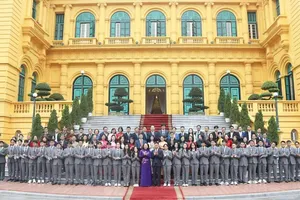
Yesterday afternoon, in Ho Chi Minh City, the Central Committee for Propaganda and Education, the National Assembly's Department of Culture and Education, the Ministry of Labor, Invalids and Social Affairs, and Dai Viet Saigon College organized a scientific workshop on training highly skilled human resources to meet the requirements of industrialization and modernization by 2030 with a vision to 2045.
In his opening speech, Head of the Department of Education Le Huy Nam emphasized that investing in the development of highly skilled human resources is essential for Vietnam’s achievements in the process of industrialization and modernization. However, the percentage of trained workers with degrees and certificates only reached 27 percent in 2023.
By the end of 2023, the nation continued to have 38 million workers who lack training. The educational attainment of the trained workforce in Vietnam remains low, with a predominant percentage of individuals having completed only junior high school (67 percent).
Furthermore, labor productivity in Vietnam is inferior to that of numerous countries within the region. Additionally, the proportion of workers receiving elementary training, lasting less than three months, remains significantly high at 75 percent.
The statistics demonstrate that the formula contributes substantially to the development of workers' technical skills.

According to Head Le Huy Nam, the low effectiveness of vocational training can be attributed to a combination of factors, including policies and laws that do not align with practical needs, a lack of robust state management capabilities at the local level, disparities in training quality among institutions, the outdated nature of many training program elements, and insufficient collaboration between training institutions and businesses, particularly in providing practical experience and contributing to program innovation.
Additionally, Mr. Nam said that most vocational education institutions face enrollment challenges and uncertainties in developing cultural teaching programs. Current support policies for vocational training are insufficient and fail to attract many people to high-tech professions. Without appropriate solutions and decisive action, this situation will severely impact human resources, particularly high-quality personnel, jeopardizing the goal of achieving industrialization by 2030 and the vision for 2045.
Deputy director Pham Vu Quoc Binh of the General Directorate of Vocational Training announced that a total of 8.4 million individuals enrolled in 1,886 public and 684 private vocational training institutions across Vietnam from 2020 to 2023
Of 8.4 million, 760,000 people posses college degrees while over 1.1 million people are at intermediate level and about 6.5 million people receive regular training.
In addition to the existing vocational training institutions, Vietnam has designated 45 schools as priority investment targets to develop into high-quality schools. These schools have successfully enrolled more than 975,000 students during the 2019-2023 period. To enhance enrollment, the schools are actively promoting programs transferred from Australia and Germany. Students who successfully complete these programs are awarded both domestic and international degrees, ensuring global recognition of their qualifications.
However, the Deputy Director attributed the failure in recruiting students after junior high school and high school to neglectfulness of local administrations which have not developed solutions to stream students. While some regions are making progress in vocational education, many others remain overly focused on preparing students for academic advancement, such as high school and university entrance exams. Investment in vocational training programs is insufficient; plus, parents and public lacks appreciation for the value of vocational education.
To promote the development of vocational education in the new period, the first solution is still to raise people's awareness of vocational education, closely link training with enterprises and the labor market, and promote training and retraining at enterprises while the autonomy of schools must be enhanced. Last but not least, Vietnam should learn from international experiences to take shortcuts, Mr. Binh emphasized.

Vice Chairwoman Nguyen Thi Mai Hoa of the National Assembly's Committee on Culture and Education said that the strengths and weaknesses of vocational training institutions have been discussed, particularly in clarifying the definition of high-quality human resources.
She emphasized the importance of a favorable legal environment for these institutions and urged the National Assembly's Committee on Culture and Education to continue overseeing government policies in this area. Additionally, she recommended that the Ministry of Labor, Invalids and Social Affairs conduct a comprehensive evaluation of the Law on Vocational Education to identify areas for improvement after ten years of implementation.
Deputy Minister Le Tan Dung of Labor, Invalids and Social Affairs said that the ministry intends to evaluate the policy mechanisms to ensure that obsolete ones will be revised to progressively alleviate challenges and shortcomings in vocational education to meet the demands of society and businesses’ human resource training in the near future.
























